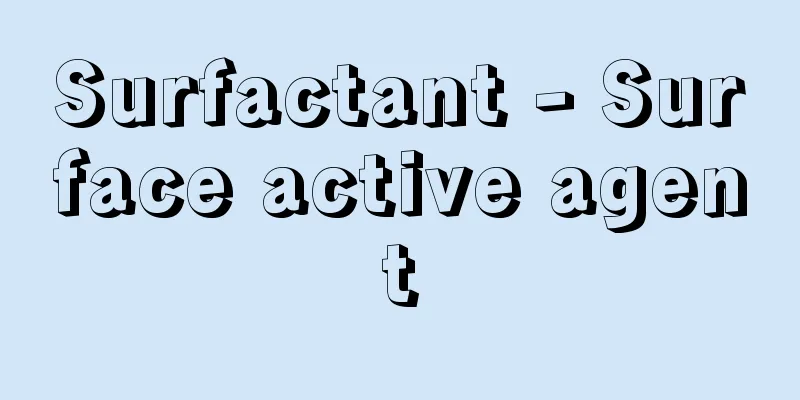Surfactant - Surface active agent

|
A surfactant is a substance that adsorbs to a surface in an aqueous solution and significantly reduces the surface tension. It is a compound that consists of hydrophilic and hydrophobic groups, and its molecular weight is several hundred to 1000. As a result of this structural feature, surfactants have an affinity for both water and oil, which are usually opposing properties (called amphiphilicity). Soap is a typical example of a surfactant. At a concentration of 1%, surfactants usually reduce the surface tension of water from 72 mN/m to 30 mN/m or less. When the concentration of a surfactant in an aqueous solution increases to a certain concentration, the surfactants that were previously monodispersed form aggregates (micelles). The concentration at which micelles form is called the critical micelle concentration (CMC). [Shigeo Hayano] ClassificationSome surfactants dissociate into ions when dissolved in aqueous solution, while others do not. Those that dissociate are further classified as anionic or cationic surfactants, depending on the ionic nature of the surface-active moiety. In addition, there are surfactants in which the surface-active moiety becomes an anion when the hydrogen ion concentration (pH) of the solution is high, and becomes a cation when the pH is low. These are called zwitterionic surfactants. Surfactants that do not dissociate when dissolved in aqueous solution are called nonionic surfactants. [Shigeo Hayano] Characteristics and ApplicationsSurfactants have properties such as wetting, penetration, emulsification, dispersion, adsorption, foaming, and solubilization, and these properties are used in a wide range of applications. (1) Wetting The reason why the surface tension of water is greatly reduced by surfactants is because the surfactants adsorb to the air-water interface and exert a force that spreads the surface against the surface tension. Similarly, when an aqueous surfactant solution comes into contact with a solid, the surfactant adsorbs to the water-solid interface and greatly changes the properties of the solid surface. For example, the surface of a plastic is normally hydrophobic and does not easily become wet by water. However, if it is immersed in a surfactant solution, it becomes easily wet by water. In this case, the hydrophobic groups of the surfactant are aligned on the plastic surface, and the outside is covered with a coat of hydrophilic groups, so it becomes wet by water. Also, it is well known in everyday life that the surface of a glass stained with oil easily repels water, but if it is washed with a surfactant solution, the thin film of oil is washed away and the surface becomes clean. All of these examples are cases where a surfactant acts on the surface to make it easier to become wet by water. Conversely, surfactants can act on water-wet surfaces to make them less wettable by water. This property is used in the manufacture of pigments, which are used as colorants in printing inks, oil paints, and coatings. (2) Micelle Micelles, which are aggregates of surfactants, have a spherical shape in a certain concentration range, with the hydrophilic groups arranged on the outside and the hydrophobic groups gathered on the inside. To create one micelle, several dozen molecules of an ionic surfactant are needed. The hydrophilic ionized parts face outward, and a strong electric field is created around the micelle. In an aqueous solution, micelles are thermodynamically stable and are treated as colloidal particles. The inside of a micelle is an area where hydrophobic groups are densely packed, but if a substance that is poorly soluble in water, such as benzene, is added to an aqueous surfactant micelle solution, the benzene is taken up by the micelle and stored in the hydrophobic group part inside. In this case, the solution is transparent and it looks as if the benzene has dissolved, so this phenomenon is called solubilization. Solubilization is used when dyeing chemical fibers such as polyester and acrylic with dyes that are poorly soluble in water, and when dispersing oil-soluble vitamins in water. It is also used in the technology of thoroughly recovering and utilizing the petroleum remaining in oil fields. (3) Emulsification When oil is dispersed in water with the help of a surfactant, the oil becomes emulsified, forming what is known as an emulsion. This phenomenon is called emulsification. In emulsification, the surfactant adsorbs around the oil droplets, stabilizing them, but when the dispersed particles are solid rather than liquid, the dispersion is called a suspension. Emulsification and suspension are important practical properties of surfactants, and they are widely used in cosmetics, polymers, margarine, road paving, etc. Surfactants used for the purpose of emulsification are called emulsifiers. (4) Cleaning The most important property of surfactants is their ability to remove dirt from and clean the surfaces of fabrics and metals, i.e., their cleaning action. Cleaning is thought to involve a complex relationship between various properties such as adsorption, wetting, solubilization, and dispersion. Detergents are products that effectively enhance the cleaning action of surfactants, but nowadays, simply having excellent cleaning power is not enough. For example, in addition to cleaning power, it is desired for household detergents to have good solubility, dirt retention, moderate foaming, moisturizing properties, odorlessness, and colorlessness. Naturally, it is also considered necessary for them to have properties such as being as low toxicity as possible, non-irritating to the skin, being decomposed by microorganisms, and having low toxicity to fish. Household detergents are primarily used to clean textiles, while industrial detergents are used for metal surface treatment, scouring in the dyeing industry, degreasing in food factories, sterilization, etc. Surfactants are the main component of detergents, and inorganic salts such as phosphates and silicates are added to enhance cleaning power. (5) Antistatic Synthetic fibers and plastics are easily charged with static electricity, and static electricity damage is likely to occur from clothing during the dry winter months. Adding a surfactant to chemical fibers can significantly prevent static electricity from occurring. This is thought to be because the surfactant present on the surface of the fiber adsorbs minute amounts of moisture in the air, increasing the electrical conductivity of the fiber surface. (6) Disinfection The bactericidal properties of quaternary ammonium compounds were discovered at the beginning of the 20th century, but it was German chemist Domagk, who was awarded the Nobel Prize in Physiology or Medicine for discovering the antibacterial properties of sulfonamides, who introduced this to the public. Cationic surfactants contain a quaternary ammonium group in the molecule, and this part exhibits cationic properties when dissolved in water. While ordinary surfactants are anionic, surfactants containing quaternary ammonium groups exhibit the opposite cationic properties, and are therefore sometimes called cationic soaps. Cationic soaps have a bactericidal effect against both gram-negative and gram-positive bacteria, and are therefore widely used in hospitals as disinfectants. [Shigeo Hayano] "Fumio Kitahara, Yasukatsu Tamai, Shigeo Hayano, and Ichiro Hara (eds.), Surfactants: Properties, Applications, and Chemical Ecology (Kodansha, 1979)" [Reference item] | |©Shogakukan "> Chemical structures and uses of typical surfactants Surfactants adsorb to the interface between air and water, and exert a force that spreads the surface against the surface tension. This significantly reduces the surface tension of the water. Micelles (aggregates of surfactants) are spherical in aqueous solution, with hydrophilic groups aligned on the outside and hydrophobic groups gathered on the inside . Molecular structure and properties of surfactants Source: Shogakukan Encyclopedia Nipponica About Encyclopedia Nipponica Information | Legend |
|
水溶液中で表面に吸着し、その表面張力を大幅に低下させる物質で、表面活性剤ともいう。親水基と疎水基から成り立っている化合物で、その分子量は数百から1000程度の大きさである。このような構造上の特徴の結果として、界面活性剤は、通常は相反する性質である水と油との両者に親和性をもっている(両親媒性という)。せっけんは界面活性剤の代表的なものである。界面活性剤は通常1%の濃度で水の表面張力72mN/mを30mN/m以下にまで下げる。水溶液中の界面活性剤の濃度がある濃度まで高くなると、それまでは単分散状態であった界面活性剤が集合体(ミセル)を形成する。ミセルが形成されたときの濃度を臨界ミセル濃度(critical micelle concentration ; CMC)とよぶ。 [早野茂夫] 分類界面活性剤には、水溶液にしたときにイオンに解離するものとしないものがある。解離するものは、界面活性を示す部分のイオンの性質に従って陰イオン界面活性剤あるいは陽イオン界面活性剤にさらに分けられる。また、溶液の水素イオン濃度(pH)が高いときには界面活性を示す部分が陰イオンとなり、pHが低くなるとそれが陽イオンになるものがある。これは両性イオン界面活性剤とよばれる。水溶液にした場合、解離をしない界面活性剤は非イオン界面活性剤と名づけられている。 [早野茂夫] 特性と応用界面活性剤には、湿潤、浸透、乳化、分散、吸着、起泡化、可溶化などの性質があり、これらを利用して広い用途をもつ。 (1)ぬれ 界面活性剤により水の表面張力が大きく低下するのは、界面活性剤が空気と水の界面に吸着し、表面張力に逆らって、表面を広げようとする力が働くからである。これと同様に、界面活性剤水溶液が固体と接するときには、水と固体の界面に界面活性剤が吸着し、固体表面の性質を大きく変える。たとえばプラスチックの表面は普通は疎水性で水にぬれにくい。しかしこれを界面活性剤溶液に浸すと水にぬれやすくなる。このときはプラスチックの表面には界面活性剤の疎水基が整列し、外側は親水基の衣が覆うので、水にぬれるのである。また、油で汚れたガラスの表面は水をはじきやすいが、これを界面活性剤の溶液で洗うと、油の薄膜が洗い取られて表面が清浄になることは日常生活でよく知られている。これらの例は、いずれも界面活性剤が表面に働いて水にぬれやすくする場合である。 その反対に、界面活性剤が水にぬれやすい表面に働いて、これを水にぬれにくくする場合もある。このような性質は印刷インキ、油絵の具または塗料の色素である顔料を製造する際に応用される。 (2)ミセルmicelle 界面活性剤の集合体であるミセルは、水溶液中では親水基が外側に並び、疎水基が内側に集められて、ある濃度の範囲では球形をしている。一つのミセルをつくるのに、イオン性の界面活性剤では数十分子の界面活性剤が必要である。親水基としてイオンに解離した部分が外側を向き、ミセルの周囲には強い電場がつくられている。水溶液中でミセルは熱力学的に安定であり、コロイド粒子として取り扱われる。ミセルの内部は疎水基が密集した領域であるが、もし界面活性剤ミセル水溶液にベンゼンのように水に溶けにくい物質が加えられると、ベンゼンはミセルに取り込まれ、内部の疎水基部分に収められる。このときは溶液は透明であり、あたかもベンゼンが溶解したようにみえるので、このような現象を可溶化という。可溶化は、ポリエステル、アクリルなどの化学繊維を水に難溶性の染料によって染色する場合や、油溶性のビタミンを水に分散させる場合に利用される。また油田に残存している石油を徹底的に回収利用する場合の技術にも応用されている。 (3)乳化 界面活性剤の助けを借りて、水中に油を分散させると油は乳濁し、いわゆるエマルジョンができる。この現象を乳化という。乳化は油滴の周囲に界面活性剤が吸着し、油滴を安定化させるものであるが、分散粒子が液体でなく固体の場合には、その分散液を懸濁液(サスペンション)とよぶ。乳化や懸濁は界面活性剤の重要な実用上の性質の一つであり、化粧品、高分子、マーガリン、道路舗装などに広く利用されている。乳化の目的に使用される界面活性剤を乳化剤とよぶ。 (4)洗浄 界面活性剤のもっとも重要な性質は、繊維や金属表面の汚れを落とし、清浄にする作用、すなわち洗浄作用である。洗浄には、吸着、ぬれ、可溶化、分散などの諸性質が複雑に関係していると考えられる。洗剤は界面活性剤の洗浄作用を効果的に高めた商品であるが、現在では単に優れた洗浄力をもつだけでは不十分である。たとえば家庭用洗剤には、洗浄力以外に、良好な溶解性、汚れの保持性、適度の泡立ち、湿潤性、無臭、無色であることなどが望まれている。また、当然のことながら毒性はできるだけ少なく、皮膚に対して無刺激であり、微生物により分解され、魚類に対する毒性が少ないことなどが必要な性質とされている。 家庭用洗剤では、主として繊維が洗浄の対象となっており、工業用洗剤では、金属表面処理、染色工業における精練、食品工場での脱脂、滅菌などがその対象になる。界面活性剤は洗剤の主成分であるが、洗浄力を増強する目的でリン酸塩、ケイ酸塩などの無機塩がさらに加えられる。 (5)帯電防止 合成繊維やプラスチックは静電気を帯びやすく、冬季の乾燥時には衣料による静電気障害が発生しやすい。界面活性剤を化学繊維に添加すると、静電気の発生が大幅に防止できる。これは繊維の表面に存在する界面活性剤が空気中の微量の水分を吸着し、繊維表面の通電性を増加させるためであると考えられている。 (6)殺菌 第4級アンモニウム化合物が殺菌作用をもっていることは20世紀の初めに発見されていたが、これを一般に紹介した人は、スルホンアミドの抗菌作用の発見者としてノーベル生理学医学賞を受賞したドイツの化学者ドーマクであった。陽イオン界面活性剤は第4級アンモニウム基を分子の中に含んでおり、水溶液にした場合にはこの部分が陽イオン性を示す。通常の界面活性剤は陰イオン性を示すのに対し、第4級アンモニウム基を含む界面活性剤はそれと反対の陽イオン性を示していることに基づいて、それらを逆性せっけんとよぶことがある。逆性せっけんはグラム陰性菌やグラム陽性菌に対して殺菌作用をもっているので、殺菌剤として病院において広く利用されている。 [早野茂夫] 『北原文雄・玉井康勝・早野茂夫・原一郎編『界面活性剤――物性・応用・化学生態学』(1979・講談社)』 [参照項目] | |©Shogakukan"> 代表的な界面活性剤の化学構造と用途 界面活性剤が空気と水の界面に吸着し、表面張力に逆らって、表面を広げようとする力が働く。これによって、水の表面張力が大きく低下する。ミセル(界面活性剤の集合体)は、水溶液中では親水基が外側に並び、疎水基が内側に集められて、球形をなす©Shogakukan"> 界面活性剤の分子構造と特性 出典 小学館 日本大百科全書(ニッポニカ)日本大百科全書(ニッポニカ)について 情報 | 凡例 |
<<: Declaration of public ownership of the sea surface - Kaimenkanyusengen
>>: Surface chemistry - kaimenkagaku (English spelling) surface chemistry
Recommend
Bag bone - Taikotsu (English spelling) os marsupiale
The proximal ends of the hind limbs of mammals art...
Cytosine
...In DNA, the sugar moiety is 2-deoxy-D-ribose, ...
Nepheline
Mineral name. Also called nepheline. Its chemical ...
Cephalocaridae
…General term for crustaceans belonging to the Ce...
Aburake - Aburake
...The name probably comes from the fact that the...
Solar wind - taiyoufuu (English spelling) solar wind
A plasma flow from the sun. Plasma particles in t...
Mitsuyoshi Yoshida
A mathematician from the early Edo period. Common...
Karukado [mountain] - Karukado
...This area is stable and has not been subject t...
Exchange profits and losses - kawase sae kisason
When you have a net receivable or payable in a for...
Nose
In humans, the nose is a part of the respiratory ...
Gustav Adolf
…reigned 1611-32. Also called Gustav Adolf. First...
Galton–Watson process
...In this case, we assume that each individual r...
King of Zhongshan
Title of the successive kings of Ryukyu (today'...
Ishigaki strawberry
Strawberries are grown early by building stone wa...
Iloilo (English spelling)
Iloilo is a port city in the southeast of Panay Is...









